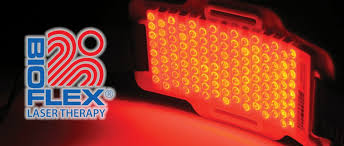How Does the Technology Work?
The technology utilizes superluminous and laser diodes to irradiate diseased or traumatized tissue with photons. These particles of energy are selectively absorbed by the cell membrane and intracellular molecules, resulting in the initiation of a cascade of complex physiological reactions, leading to the restoration of normal cell structure and function.
In the short term, the body products and releases beta-endorphins to control the sensation of pain. Plus, cortisol production is increased to combat the stress associated with the trauma or disease process.
Over the long term, ATP (adenosine triphosphate) production is increased resulting in improved cellular  metabolism. DNA (deoxyribonucleicacid) production, the protein building block of tissue, is substantially increased. Neurotransmission is facilitated secondary to elevated levels of serotonin and aceytylcholine. Mitochondrial activity is stimulated resulting in cell replication for replacement, regeneration and repair of abnormal cells. And other cellular level changes take place.
metabolism. DNA (deoxyribonucleicacid) production, the protein building block of tissue, is substantially increased. Neurotransmission is facilitated secondary to elevated levels of serotonin and aceytylcholine. Mitochondrial activity is stimulated resulting in cell replication for replacement, regeneration and repair of abnormal cells. And other cellular level changes take place.
The process results in the elimination of symptoms, including pain, and enhances the body’s immune system response, facilitating natural healing.
How Does it Work?
Laser therapy is the use of light from a Low Intensity Laser Diode or an array of Superluminous Diodes to eliminate pain, accelerate healing and decrease inflammation. LLLT is also known as cold laser, low intensity laser therapy or photobiomodulation.
Laser therapy does not heat or cut tissue, unlike high intensity lasers. Many pharmacological treatments mask pain or only address the symptoms of the disease; laser Therapy treats the underlying condition or patho
logy to promote healing. This means that the treatments are effective and the benefits of laser therapy are long lasting.
A Treatment Overview
- Professional assessment
- Review of the recommended treatment plan
- Review of the expected outcomes
- Begin your treatments
What Conditions Does it Treat?
Soft Tissue and Sports Injuries
-
- Ligament & Tendon Tears
- Muscle Strains
- Tendonitis
- Contusions
Arthritic changes
- Degenerative Osteoarthritis
- Rheumatoid Arthritis
- Vertebral Radiculopathy
- Chronic Spinal Problems

Repetitive stress injuries
- Carpal tunnel syndrome
- Rotator Cuff Injuries
- Tennis Elbow
General health problems
- Herniated Disc
- Fibromyalgia
- Temporo-Mandibular Joint Syndrome
- Reflex Sympathetic Dystrophy
- Post Herpetic Neuralgia
Tissue repair and wound healing
- Traumatic Lesions (burns)
- Dermal Ulcers
- Venous Stasis
- Compression

